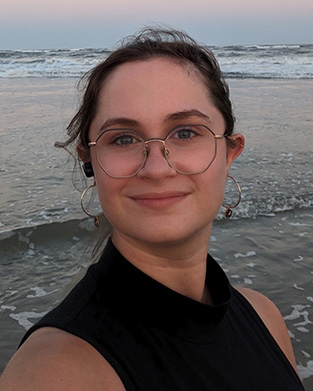
Graduating Drexel Materials BS/MS student Marley Downes is heading off to graduate school with significant research discoveries made at Drexel and a prestigious National Science Foundation Graduate Research Fellowship Program (NSF-GRFP) fellowship.
Marley came to Drexel knowing exactly what she wanted to study. “I always liked chemistry. I liked understanding how things work. But I wanted to do it from an applied side, from an engineer’s point of view,” she says. During her first year, she was drawn to the materials science and engineering program. “It’s like solid-state chemistry, where you study the chemistry of solid materials, and their structure and property relations. That’s what I’d like to be able to understand - these things have their properties because they’re bonded a certain way and that sort of thing.”
After her first year, she participated in the Students Tackling Advanced Research (STAR) Program, conducting research on MXenes with the A.J. Drexel Nanomaterials Institute (DNI), led by Distinguished University and Bach Professor Yury Gogotsi. Her STAR project investigated the lithium poly-sulfide absorption capabilities of MXenes, two-dimensional materials discovered at Drexel in 2011, to inform the possibility of applying MXenes in lithium sulfur batteries to extend their lifetime.
Through her participation in STAR, Marley realized that what really intrigued her was investigating the synthesis and special properties of MXenes. To explain what’s so fascinating about MXenes, Marley says, “Imagine they’re like a sandwich. Your bread is an atomic layer of transitional metal, like titanium, and the stuff in the middle is an atomic layer of something like carbon or nitrogen. So that’s the basis of a MXene, and then you can stack your layers. You can switch out your transition metals. They’re really fantastic and lovely because they have all these interesting properties that you can tune by changing both your elements and the number of layers.”
For her first co-op Marley continued to work in the DNI to understand the effect of atomic thickness on the properties of MXenes. This eventually evolved into her MS thesis project in which she is measuring the properties of discovered MXenes to determine if the number of layers they have affects their properties. It also inspired Marley to try for her own discovery. “My work revolves around that fact that we know of some [MXenes], and we know that there are more. We have theoretical computations showing there are more. How can we make them and see what they can actually do? I was primarily working with MXenes with two, three, and four layers. There was only one with five layers. I said well, I’m going to try to find more of these five-layer MXenes.”
While she was on her second co-op at W.L. Gore, Marley would end her workday and go back to the DNI lab to continue searching for new MXenes. Her commitment ultimately paid off. “I was able to find and synthesize two new five-layer MXenes,” she says. “New material discovery is very exciting. I’m not a big applications person, I like fundamental science. So this was more down the line of what I like to do.”
By demonstrating that a range of two-dimensional materials with five layers can be synthesized, Marley opened the door to a major expansion of the MXene family. From a functional standpoint, five-layer MXenes can potentially exhibit better conductivity or thermal stability than thinner members of the MXene family. Her discovery resulted in a publication in ACS Nano with Marley as the first author.
Along the way, Marley has also become something of an expert in MXene synthesis; so much so that she is the first author on another paper recently published in Nature Protocols providing a comprehensive review of the synthesis of Ti3C2Tx, the most widely utilized MXene.
Marley credits the experiential learning and undergraduate research opportunities available at Drexel for contributing to her success. “Stuff like the STAR program really helped shape my path, and also having that freedom where I don’t really know what I want to do but I have the ability to try out different things. We have the Material Characterization Core with multimillion dollar characterization equipment that you can be trained on and use as an undergrad! I’m a user on a lot of them. Being able to do that, the actual hands-on experience of it all, really helped strengthen my skills. I know students at other schools who haven’t had the opportunity to do that because their school doesn’t have that hands-on mindset.”
Another significant factor for Marley is the encouragement she has received from Professor Yury Gogotsi, who serves as her thesis advisor. “He’s always encouraged me to try different things with my research, to try a bunch of different ways. The reason I’ve gotten into the University of Chicago and I’ve gotten scholarships and awards is that he has always been supportive.”
The NSF-GRFP fellowship that will support Marley’s PhD studies at the University of Chicago is awarded to outstanding graduate students who have demonstrated the potential for significant research achievements early in their careers. For Drexel Materials department head Steve May, Marley was a clear choice for this award. “I have no doubt that Marley is in the elite top tier (upper 1%) of undergraduate students in terms of academic performance, research experience, leadership potential and trajectory to make major research impacts throughout her career,” he says. “She is an emerging superstar in the field of two-dimensional materials and is exceptionally well-deserving of a prestigious GRFP fellowship.”